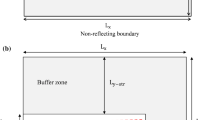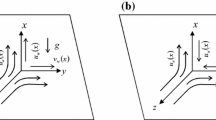Abstract.
The linear stability of inviscid compressible shear layers is studied. When the layer develops at the vicinity of a wall, the two parallel flows can have a velocity of the same sign or of opposite signs. This situation is examined in order to obtain first hints on the stability of separated flows in the compressible regime. The shear layer is described by a hyperbolic tangent profile for the velocity component and the Crocco relation for the temperature profile. Gravity effects and the superficial tension are neglected. By examining the temporal growth rate at the saddle point in the wave-number space, the flow is characterized as being either absolutely unstable or convectively unstable. This study principally shows the effect of the wall on the convective–absolute transition in compressible shear flow. Results are presented, showing the amount of the backflow necessary to have this type of transition for a range of primary flow Mach numbers M 1 up to 3.0. The boundary of the convective–absolute transition is defined as a function of the velocity ratio, the temperature ratio and the Mach number. Unstable solutions are calculated for both streamwise and oblique disturbances in the shear layer.
Similar content being viewed by others
Author information
Authors and Affiliations
Additional information
Received 9 May 2001 and accepted 21 August 2001
Rights and permissions
About this article
Cite this article
Robinet, JC., Dussauge, JP. & Casalis, G. Wall Effect on the Convective–Absolute Boundary for the Compressible Shear Layer. Theoret Comput Fluid Dynamics 15, 143–163 (2001). https://doi.org/10.1007/PL00013290
Issue Date:
DOI: https://doi.org/10.1007/PL00013290




